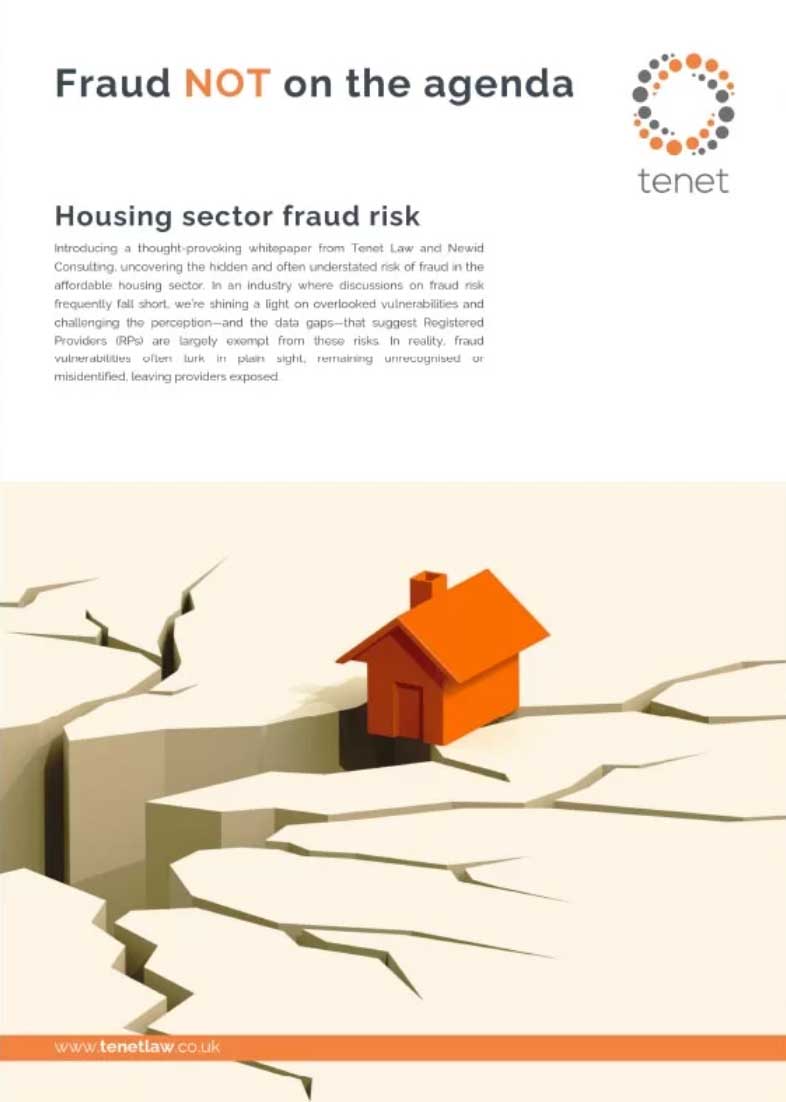Image: Istock
Criminal behaviour – recognising the red flags
Organised Crime Groups are targeting the housing sector, so how can your organisation protect itself?

RISK & ASSURANCE

Arun Chauhan
Lawyer specialising in fraud and financial crime, Tenet

Elaine Mitchell
Lawyer specialising in financial crime compliance, Tenet
Issue 75| December 2024
Housing associations are particularly vulnerable to fraud. Fraudsters target housing associations in many ways – from providing proceeds of crime to a tenant to fund a purchase, to using a property for illegal activities, such as growing cannabis, drug dealing, human trafficking and prostitution. When considering the nature of the work and services in this sector, a greater focus on the risk of fraud is necessary.
While sectors such as construction and real estate recognise their risk of fraud and money laundering, the housing association sector, which shares similarities to these other sectors, has not uniformly adopted tackling fraud risk as a compliance issue. This is despite the new Failure to Prevent Fraud offence coming into effect in the spring of 2025.
By raising awareness, housing associations and their employees can be alert to red flags, help combat financial crime and minimise the risk of breaching the new Failure to Prevent Fraud offence.
What are Organised Crime Groups?
Section 45 of the Serious Crime Act 2015 defines an Organised Crime Group as “3 or more persons who act (or agree to act) together to further the carrying on of criminal activities”.
Earlier this year, Europol published a report on the most threatening criminal networks active in the EU. They identified 821 OCGs involving some 25,000 individuals who are active in a range of criminal activities, including drug trafficking, fraud, property crime, migrant smuggling and human trafficking.
Organised Crime Groups identified by Europol, involving some 25,000 people
According to Europol, the most common traits of OCGs are:
- Agile – 86% of the most threatening criminal networks use legal business structures to infiltrate sectors such as construction, hospitality and logistics. OCGs are resilient to law enforcement (280 of the 821 have been active for 10+ years) because violence and/or corruption enable them to obtain information about investigations and apply countermeasures.
- Borderless – OCGs have global reach, although they often focus their criminal activity on a region or a limited number of countries.
- Controlling – OCGs maintain control over their criminal operations by specialising in one main criminal activity, such as drug or people trafficking. When additional expertise or assistance is required, they often delegate to external providers, such as minors. Europol found that 96% of these OCGs launder their criminal proceeds themselves.
- Destructive – The criminal activities of OCGs inflict significant damage on security, the rule of law and the economy with the most common criminal activities affecting millions of people.
How do OCGs infiltrate the housing sector and how do we prevent it?
OCGs are known to be infiltrating the housing sector in several ways. Most notably:
1. Cuckooing – OCGs take over a person’s home and use the property to carry out illegal activities, such as dealing, storing and taking drugs; housing migrants or victims of human trafficking; or using the property as a brothel.
The key signs are multiple people visiting the property at various times of the day and night and an increase in antisocial behaviour. If there are any such suspicions, the police, and possibly the National Crime Agency, should be informed.
“Key signs are multiple people visiting the property at various times of the day and night and an increase in antisocial behaviour.”
2. Tenancy fraud – OCGs launder their proceeds of crime by giving it to a tenant to fund the purchase of their property, taking advantage of the huge discounts afforded to tenants and their often vulnerable nature.
Right to Buy/Acquire teams must carry out adequate checks on the source of wealth/funds being used before proceeding.
3. Chargeback – OCGs befriend vulnerable tenants and offer to pay their rent. They do this using the housing association’s telephone payment facility and then submit a chargeback claim to their bank, asserting that they knew nothing about the transaction and are the victim of fraud.
Housing associations must review how payments are taken, especially where changes to the payment method are made. We suggest this change should only be accepted where there has been verified human interaction with the tenant and a satisfactory explanation for the change.
4. Supplier takeover – OCGs have been known to acquire the ownership of incumbent suppliers of various organisations, such as the NHS and charities. Housing associations are an obvious further target. These might include house builders or property repair companies, who ultimately take control of the supplier and provide inferior quality or overcharge for the work.
Housing associations should check for changes in the control of suppliers through routine due diligence.
Fraud risk is something that housing associations need to be alert to. The start of that journey is knowing the risks and detecting them. This depends largely on whether employees are trained to detect defined red flags, and whether the necessary policies and procedures are in place and being followed.


